Age-Related Nuclear Cataract can be reduced by Healthy Diets !
Cataract has been a most common cause for the vision loss in the people of age over than 40. It has been a major principal for causing the blindness all over the world.In the today's world, there has been more cases of the cataract than the glaucoma, Retinopathy and other conditions .
So, What literally is cataract ?
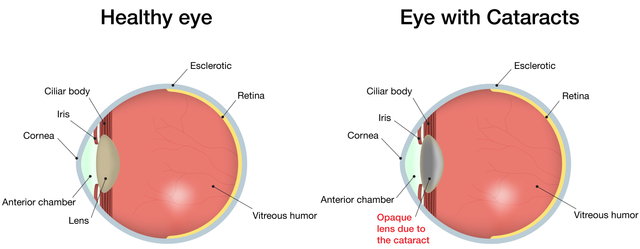
Fig: Eye lens in healthy and with Cataract (source)
A cataract is something that clouds the lens in the eye leading to decrease in vision. This can affect one or both of the eye of a person. It starts out slowly and small .Firstly, it will affect in the vision. Something like blurred a little or watching the world through a cloudy piece of glass or painting occurs.The lights from the sun or a lamp becomes too much bright or glare seems to originate. When driving through the highways, the oncoming headlights makes more glare than before. Watching the beautiful flowers or dresses with the original colors may not be bright as before.
Before going deep into this topic, here is a brief intro on the lens !
Fig: Lens position (source)
Lens is a clear part of the eyeball that helps in focusing light or an image in the retina. Lodging in the patellar fossa and holded by some zonule fibres, it acts as the camera lens in focusing the objects.The retina is a light sensitive tissue present in the back of the eye which helps in forming the image. In the normal eye, the light energy passes across the transparent lens and focus on the retina where photo-transduction (conversion of light energy signals to electrical signal) takes place and trasferred to the brain for further process.
Lens has a highest concentration of protein .The surface ectoderm lines it and makes it crystalline. Its a biconvex one. The power of lens ranges from 15-17D. Lens has maximum of beta-protein (55% protein) . Protein is arranged in so much precise way that it keeps the lens clear and makes the light energy pass through it. Lens has no vascular supply rather it takes it nutrients from the aqueous humor by diffusion process. Its divided into two parts:
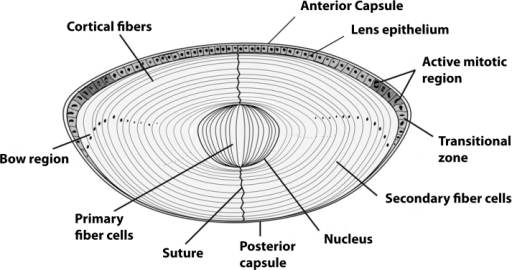
Fig: Lens part division (source)
- Outer- Cortical part of lens
- Inner - Nuclear part of lens.
The refractive index of Cortical part is 1.39 where as the refractive index of Nuclear part is 1.42. The Refractive index of the Nuclear part is more than Cortical part because the Nuclear part has no water mass in it.
Have a look at this picture ,
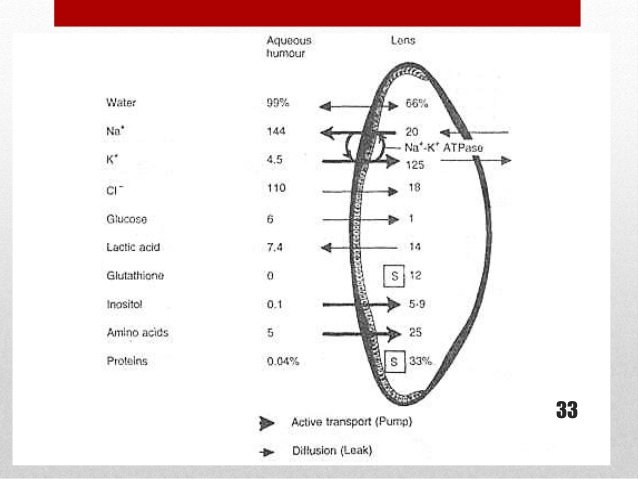
Fig: Lens and aqueous humor transport mechanism (source)
The constituents gets exchanged from the aqueous humor and gets supply to healthy lens. The constituents of water is only high in the aqueous humor rather than lens . The Na+/K+ pump playes a great role in maintaining the water balance and anti-oxidant mechanism . This helps in protecting the lens form getting denatured from protein. The Cortical part becomes metabolically highly active rather than Nuclear part in case of Na+/K+ pump mechanism. In cases of old ages, the pump fails to work efficiently and the water content inside the lens with Na becomes high leading to hydration ,decreased transparency, increased Opacity.Protein clumps together and starts forming clouds in a small area of the lens and slowly grows larger over time making hard to visualize world.
So, When some denaturation of protein of lens takes place, there is the generation of Cataract.
Types of Cataract :
- Congenital Cataract :
Also called as the developmental Cataract.This type of cataract develops in the born babies or develop in the childhood oftenly in both of the eyes. Developing in the Nuclear region of the lens, called as Contracta centralis perverulenta has no vision loss but Zonular or Lamellar cataract has some sort of vision loss in the childhood and it's the most common cataract in childhood causin vision loss. In case of generalized condition, Punctate cataract (blue dot cataract) is the most common cataract in congenital phase without vision loss. The main causes can be of :
Maternal cause -
- Drugs like thalidomide, corticosteroids
- STORCH infection (Syphilis, Toxoplama,Other,Rubella,Cytomegalovirus,Hepes virus)
- Deficiency of Vitamin A,B,C,E (anti-oxidants)
- Radiations
Fetal Cause -
- A-Anoxia (decreased oxygen supply)
- B-Birth trauma (obstructive labor, labor period increased, decreased oxygen supply)
- C-Congenital Cataract
- Acquired Cataract :
This type of cataract is formed from Vitamin D deficiency, hypocalcemia and hypothyroidism . The rubella infection occuring in the maternal for about 7-8 weeks of period of gestation can also give rise to Cataract.
According to Morphological aspect, Cataract can be seen as :
- Capsular Cataract
- Subcapsular Cataract
- Cortical Cataract (Senile Cataract) ; most common in old ages, most common cataract
- Nuclear Cataract
- Supra-nuclear Cataract
- Polar Cataract
How does it become hard to see ?
As the clumps of protein reduces the sharpness of images by clouding the lens.This clumped up cloud reduces the light reaching the lens and makes it blurred vision.Mostly, this is occurred in Old age people so called as age-related cataract. This firstly starts off from small area and takes more space gradually and in the other hand the vision is decreased in parallel fashion.
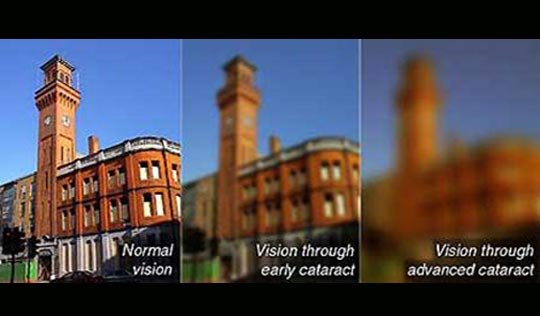
Source

Source

Source
Fig: Vision of cataract person
Lens starts to grow in grayish yellow color which adds by brownish tint in vision .It gets Dark yellow or amber color due to the deposition of Urochrome pigment and convert to full brownish color. Over timely, there is the daily routine change in the reading and performing activities.Lately, it it converted to black and last to red. During these cases, the purple and black color is hard to distinguish because if tinting of lens.
Probably, most of the Cataract is detected from Visual Acuity Test where a chart has some measurements and patients visual is measure accordingly. Dilated eye exam is the important one as the patients eye is dilated and widened even the pupils for checking the optic nerve damage or retina damages. Tonometry is the process measuring the pressure inside the eye.
When it comes for treatment, surgery is the only remedy ! IntraOcular Lens is used in many cases which is a artificial lens .
Coming to the topic, the healthy diet has some association with the lower risk in developing the Age-Related Nuclear Cataract (ARNC). Many studies suggest that certain nutrients and nutritional supplements can reduce the risk of cataracts. Health professionals found about the high dietary intake of carotenoids zeaxanthin and lutein and even vitamin E from food supplements associated with decreasing risk of cataracts. Vitamin E rich sources like sunflower seed, spinach and almonds plays a great role.
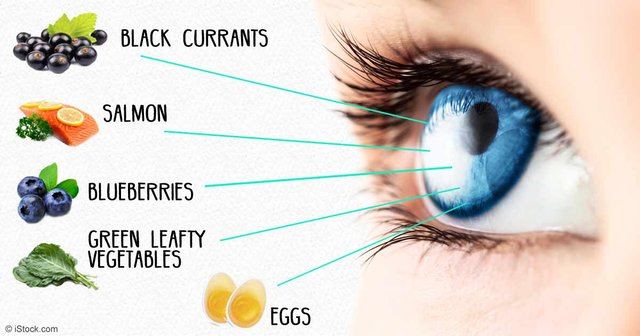
Fig: Diets that maintain healthy eye (source)
Evidences on the relationship between the Age-Related Disease and gut microbiome is increasing progressively. The Cataract risk is generated by some systemic factors which is mediated by some gut bacteria. Some study finds some difference between the gut bacteria in people eating healthy diets and those who ate other foods. Those bacteria which digest plant materials are the ones that are associated with the healthy diets and protecting against cataract. Healthy Eating Index (HEI) is assessed in calculating the healthy food intake. The HEI is inversely proportional to the Age-Related Nuclear Cataract risk. Bacteria called as Ruminococcaceae is more significantly associated to the Age-Related Nuclear Cataract . Mogibacteriaceae is associated in less manner.
Diet provided with more anti-oxidant vitamins like Vitamin C and D foods contains Omega-3 fatty acids has role in reducing the risk for Cataract to occur.
So this all about today's health topic. Hope to see on other blogs.
Thanks for reading !
With love ,
khatisam4

Source:
(1)http://www.allaboutvision.com/conditions/cataracts.htm
(2)https://www.medscape.com/viewarticle/881028
(3)http://www.visionaware.org/info/your-eye-condition/cataracts/different-types-of-cataracts/125
(4)https://www.aao.org/bcscsnippetdetail.aspx?id=65f250db-712d-43c4-b452-d4559112ac47
Last Health Post:
Discovery of MUC5B gene in hearing loss of Otitis MEdia with Effusion Patient
Thanks for sharing about it in details very useful :)
Thanks @blazing for going through the post :)
Sorry for jumping in - love the message on your profile. Cheers!
This surely is a remedy for those in need.
That sounds like a hope for many. Thanks for sharing!
Yes, there will be ! If people follows the adequate diets, not only ARNC, other diseases can also be prevented !
That's great! :)